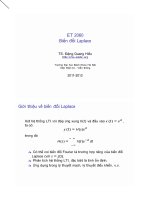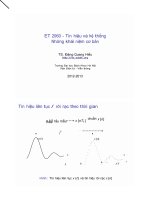Đề thi Tín hiệu và hệ thống kì 1 năm học 2014-2015 - UET - Tài liệu VNU
Bạn đang xem bản rút gọn của tài liệu. Xem và tải ngay bản đầy đủ của tài liệu tại đây (285.96 KB, 3 trang )
<span class='text_page_counter'>(1)</span><div class='page_container' data-page=1>
VIETNAM NATIONAL UNIVERSITY, HANOI
<b>University of Engineering and Technology</b>
<i>Date: December 24, 2014</i>
<b>FINAL EXAMINATION</b>
<b>Course: Signals and Systems (ELT2035 4)</b>
Duration: 90 minutes
<i><b>Part 1 (Multiple-choice questions): For problems in this part, you only have to</b></i>
<i>give the letter of the correct answer (A/B/C/D). Explanations are not required.</i>
<b>Problem 1. Which one of the following signals is an energy signal?</b>
<i>A. x (t)=sin (3π t)[u(t )−2 u(t−4)]</i>
<i>B. x (n)=2</i>−|<i>n|<sub>cos(π n/3)</sub></i>
<i>C. x (n)=nu (−n)</i>
<i>D. x (t)=(e2t</i>−e−3 t)<i>u(t)</i>
<i>Answer: B</i>
<b>Problem 2. Which one of the following LTI systems can be both causal and stable?</b>
A.
<i>y (t)−dy(t)</i>
<i>dt</i> +
<i>d</i>2<i><sub>y(t)</sub></i>
<i>dt</i>2 =<i>x(t)+</i>
<i>dx (t)</i>
<i>dt</i>
<i>B. y (n)+2 y (n−1)=x (n)</i>
<i>C. dy(t)</i>
<i>dt</i> +
<i>d</i>2<i>y (t)</i>
<i>dt</i>2 =2 x(t )
<i>D. 8 y (n)+2 y (n−1)−y (n−2)=x(n−1)</i>
<i>Answer: D</i>
<b>Problem 3. The frequency response of a continuous-time LTI system exists and is</b>
given by:
<i>H (ω)=</i> 2
ω2+<i>3 j ω−2</i>
which one of the following statements about this system is correct?
A. This system is causal.
B. This system is anti-causal.
C. This system is non-causal (not causal nor anti-causal).
<i>Page 1/3</i>
</div>
<span class='text_page_counter'>(2)</span><div class='page_container' data-page=2>
D. This system is not stable.
<i>Answer: B</i>
<b>Problem 4. Which one of the following statements is correct?</b>
A. The Fourier spectrum of a discrete-time energy signal is continuous
and periodic.
B. The Fourier spectrum of a discrete-time energy signal is continuous
and non-periodic.
C. The Fourier spectrum of a discrete-time energy signal is discrete and
periodic.
D. The Fourier spectrum of a discrete-time energy signal is discrete and
non-periodic.
<i>Answer: A</i>
<i><b>Part 2 (Exercises):For problems in this part, detailed explanations/derivations</b></i>
<i>that lead to the answer must be provided.</i>
<b>Problem 5. Given a causal LTI system described by the following differential</b>
equation:
<i>y (t)+3dy (t)</i>
<i>dt</i> +2
<i>d</i>2<i>y (t)</i>
<i>dt</i>2 =<i>x(t )+2</i>
<i>dx(t )</i>
<i>dt</i>
a) Determine the impulse response of the given system.
b) Determine the initial response <i>y</i><sub>0</sub>(<i>t)</i> of the given system to the
<i>following initial conditions: y(0</i>) = 1 and <i>dy (t)</i>
<i>dt</i> <i>t=0</i>= 1.
c) Determine the zero-state response <i>y<sub>s</sub></i>(<i>t)</i> of the given system to the
<i>input signal x(t )=e</i>−2 t<i><sub>u(t) .</sub></i>
<i>Answers:</i>
<i>a) Inverse Laplace transform of H (s)=</i> <i>2 s+1</i>
<i>2 s</i>2+3 s+1=
1
<i>s+1 (h(t) is</i>
<i>causal).</i>
<i>b) Use unilateral Laplace transform or solve the homogeneous equation</i>
<i>with initial conditions directly.</i>
<i>c) Inverse Laplace transform of</i> <i>Ys</i>(<i>s)=H (s) X (s)</i>
<i>Page 2/3</i>
</div>
<span class='text_page_counter'>(3)</span><div class='page_container' data-page=3>
<b>Problem 6. Given a system T described by the following block diagram:</b>
<b>in which, S1</b> is a continuous-time linear time-invariant system described by the
<i>differential equation y (t)+dy (t)</i>
<i>dt</i> =
<i>dx(t)</i>
<i>dt</i> <b>and the feedback block S2</b> has the
transfer function of <i>H</i><sub>2</sub>(<i>s)= 1</i>
<i>s−1</i> .
<b>a) Determine the transfer function of T.</b>
<b>b) Determine the frequency response of system T when: i) T is causal,</b>
<b>and ii) T is anti-causal.</b>
<b>c) Determine the output of system T to the input</b> <i>x(t )=sin (t /3)</i> <b> when:</b>
<b>i) T is causal, and ii) T is anti-causal.</b>
<i>Answers:</i>
<i>a)</i> <i>H (s)=</i> <i>s(s−1)</i>
<i>s</i>2+<i>s−1</i>
<i>b) i) H (ω)=H (s)s= j ω</i> <i>, because the system is stable; ii) not exist,</i>
<i>because the system is not stable.</i>
<i>c) i) y (ω)=</i> 1
<i>2 j</i> <i>H ( j/3)e</i>
<i>t /3</i><sub>−</sub> 1
<i>2 jH (− j /3)e</i>
−<i>t /3</i>
<i>; ii) infinity, because the</i>
<i>frequency response does not converge at the frequency of the input</i>
<i>sinusoidal signal.</i>
***** END *****
<i>Page 3/3</i>
<b>S<sub>1</sub></b>
<b>S<sub>2</sub></b>
In Out
</div>
<!--links-->









